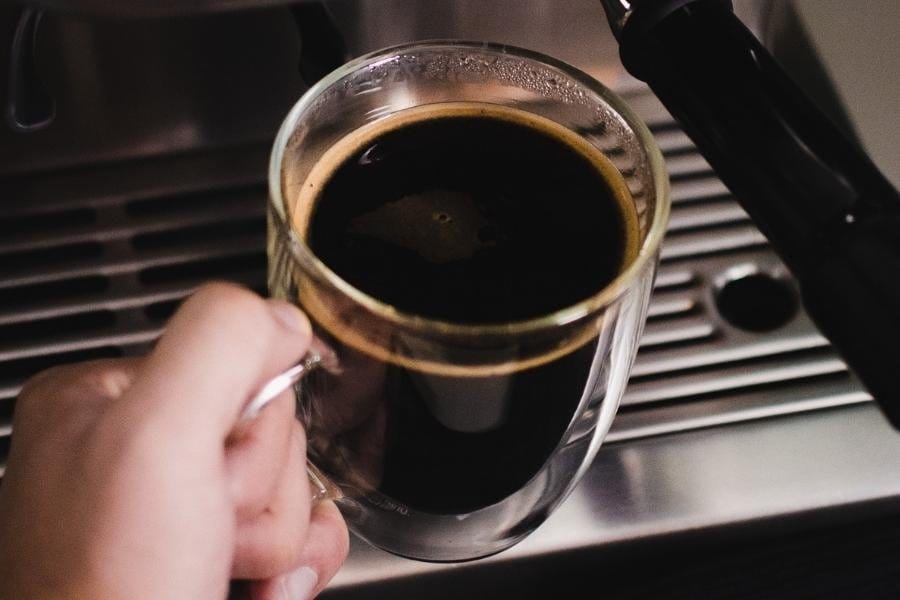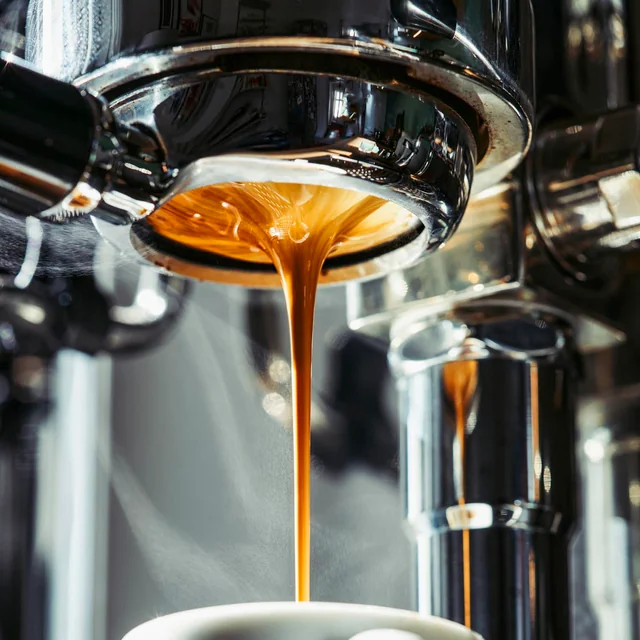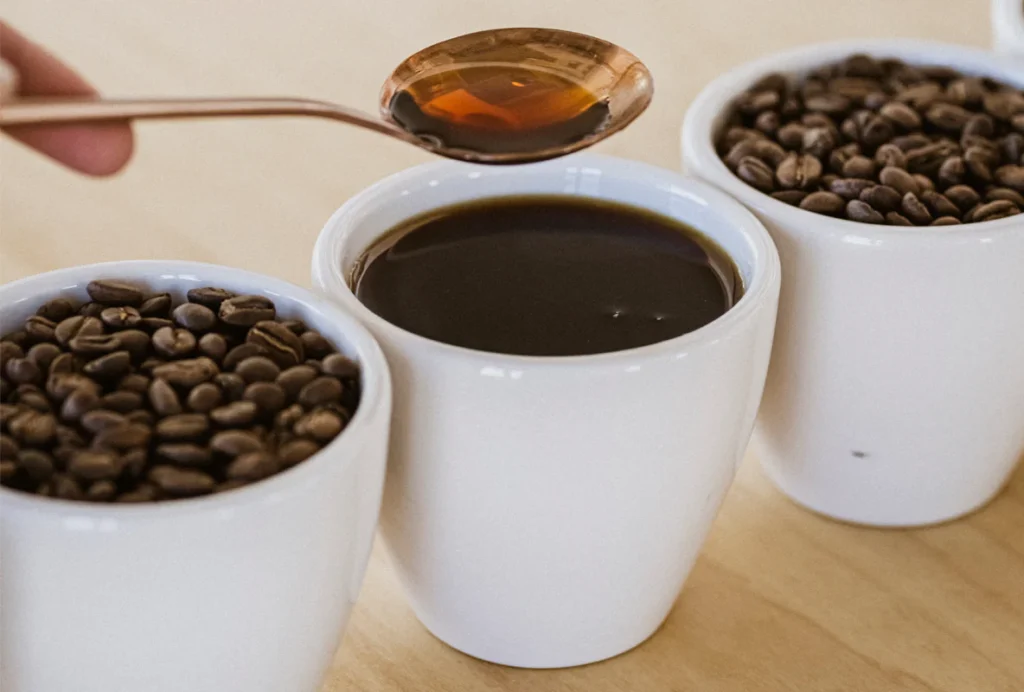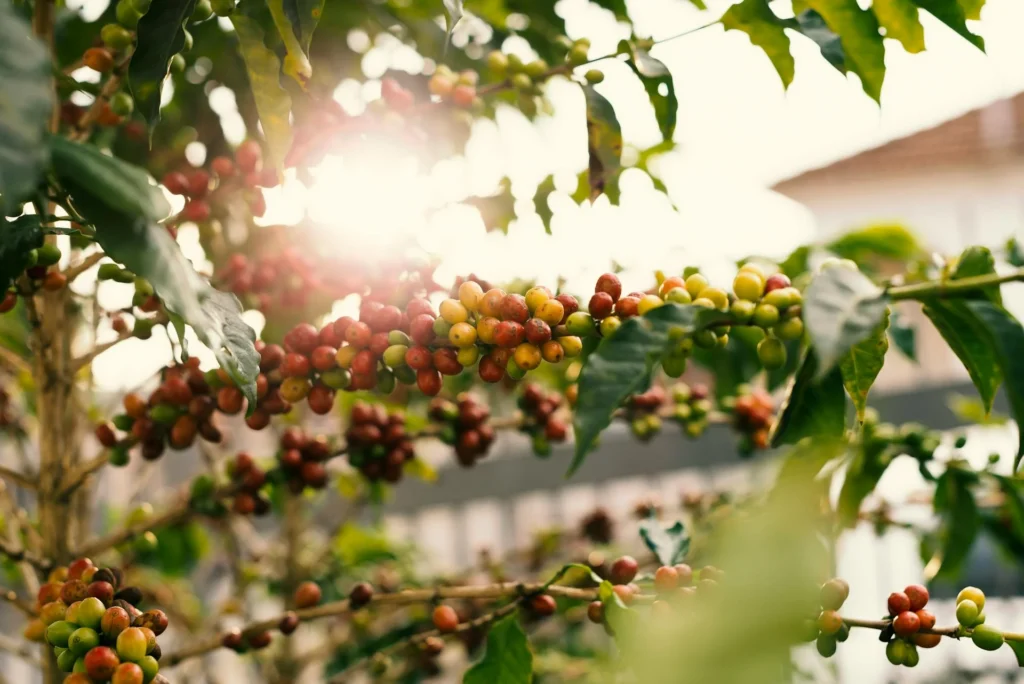When it comes to coffee, two popular choices that often spark debate are the Americano and the Espresso. Both drinks have unique characteristics, origins, and preparation methods, making them favorites among coffee enthusiasts.
This article will explore the primary differences between Americano vs Espresso, delving into their origins, preparation methods, and taste profiles to help you understand what sets them apart and which one might suit your taste preferences.

What is an Espresso?
Espresso is a concentrated coffee beverage that originated in Italy in the early 20th century. Known for its rich flavor and thick, creamy texture, espresso serves as the foundation for many other coffee drinks. The brewing process involves forcing hot water through finely-ground coffee beans at high pressure, resulting in a small but potent shot of coffee.
The unique preparation method of espresso sets it apart from other coffee drinks. The high-pressure extraction process not only captures the intense flavors and aromas of the coffee beans but also creates a layer of crema on top—a creamy, golden foam that adds to the espresso’s distinctive texture. This crema is a hallmark of a well-prepared espresso and is a key indicator of quality.

Espresso’s flavor profile is bold and robust, with a balance of bitterness and sweetness. Its texture is smooth and velvety, providing a full-bodied coffee experience that lingers on the palate. Unlike other brewing methods, which can dilute the coffee’s flavors, espresso delivers a concentrated and intense taste, making it a favorite among coffee purists.

What is an Americano?
An Americano, or Caffè Americano, is a popular coffee drink with a unique origin story. Legend has it that during World War II, American soldiers stationed in Italy would dilute their espresso with hot water to make it more similar to the drip coffee they were accustomed to back home. This method of preparation gave rise to the Americano, a name that reflects its American roots.
To prepare an Americano, a shot of espresso is combined with hot water. The typical ratio is one part espresso to two parts water, although this can be adjusted to suit individual taste preferences. This dilution process results in a coffee drink that has the depth and complexity of an espresso but with a milder and more approachable flavor.

The flavor profile of an Americano is distinct from that of a straight espresso. While it retains the rich, bold notes of the espresso, the added water tempers the intensity, making the drink smoother and less concentrated. This allows the subtler flavors of the coffee beans to come through, providing a balanced and enjoyable cup of coffee that is less bitter and more palatable to those who might find espresso too strong.
Compared to other coffee types, the Americano stands out for its simplicity and versatility. It can be enjoyed black or with added milk and sweeteners, making it a versatile option for coffee lovers who appreciate the nuanced flavors of espresso without the overwhelming strength.

Key Differences Between Americano and Espresso
Understanding the key differences between an Americano and an Espresso can help you appreciate the unique qualities of each coffee beverage. Let’s dive into a comparative analysis focusing on the brewing process, taste, caffeine content, and typical consumption contexts.
- Brewing Process: Espresso is made by forcing hot water through finely-ground coffee beans under high pressure, resulting in a small, concentrated shot. An Americano, on the other hand, is prepared by adding hot water to a shot of espresso, diluting it and creating a larger cup with a different flavor profile.
- Taste: Espresso offers a bold, robust flavor with a balance of bitterness and sweetness and a smooth, velvety texture. In contrast, an Americano has a milder taste. The added water tempers the espresso’s intensity, making it smoother and allowing more subtle flavors to emerge, resulting in a less bitter, more balanced coffee.
- Caffeine Content: Both drinks use espresso as a base. Espresso has a high caffeine concentration in a small volume. An Americano, with added water, has a lower caffeine concentration per ounce, but because it is typically consumed in larger quantities, the total caffeine content can be comparable to that of an espresso, depending on the serving size.

Espresso is often enjoyed as a quick, concentrated shot, ideal for those seeking an immediate caffeine boost or a rich coffee flavor. It is commonly consumed in small quantities and is a staple in coffee bars and cafés around the world. An Americano, with its larger volume and milder flavor, is more suited for leisurely sipping. It can be enjoyed black or with milk and sweeteners, making it a versatile choice for various contexts, whether as a morning pick-me-up or an afternoon coffee break.
Brewing Techniques
When comparing Americano vs Espresso, the brewing techniques play a crucial role in defining their unique characteristics. Let’s take an in-depth look at the equipment and methods used to prepare each beverage.
Espresso Brewing Technique
Espresso brewing requires specialized equipment, namely an espresso machine. This machine forces hot water through finely-ground coffee beans at high pressure, typically around 9 bars. The process takes approximately 25-30 seconds, resulting in a small, concentrated shot of coffee.

The key components of the espresso brewing process include:
- Espresso Machine: A device designed to brew coffee by forcing pressurized water near boiling point through a “puck” of ground coffee.
- Grinder: A high-quality burr grinder ensures a consistent, fine grind necessary for optimal extraction.
- Tamper: Used to evenly compress the ground coffee in the portafilter, ensuring uniform extraction.

This method produces a rich, full-bodied coffee with a layer of crema on top, a signature of a well-made espresso.
Americano Brewing Technique
The Americano, while starting with an espresso base, involves a simpler preparation method. After pulling a shot of espresso using the technique described above, hot water is added to the espresso. The typical ratio is one part espresso to two parts hot water, although this can be adjusted based on personal preference. Understanding this transformation is crucial when delving into how espresso is utilized in coffee drinks like latte, and Americanos.

The key steps in preparing an Americano include:
- Pulling an Espresso Shot: Using an espresso machine, as detailed above.
- Adding Hot Water: The hot water is usually added after the espresso to preserve the crema, but some variations add water first, followed by the espresso.

The equipment needed for an Americano is essentially the same as for an espresso, with the addition of a hot water source, which is often part of the espresso machine.
Flavor Profiles
The flavor profiles of Americano and Espresso are distinct, catering to different palates and offering unique coffee experiences. Let’s explore how each beverage is perceived and their suitable food pairings.
Espresso Flavor Profile
Espresso is renowned for its bold, intense flavor. The high-pressure extraction method captures the essence of the coffee beans, resulting in a rich, concentrated shot. This intense brewing method is crucial in exploring the distinctions between espresso and coffee, providing a foundation for understanding their strength and depth.
The flavor is typically robust, with a harmonious balance of bitterness and sweetness. Espresso often features notes of chocolate, caramel, and nuts, depending on the bean origin and roast profile. Its velvety texture and lingering aftertaste make it a favorite among coffee aficionados who appreciate a strong, unadulterated coffee experience.

Espresso pairs well with:
- Dark Chocolate: Enhances the deep, rich flavors of the espresso.
- Biscotti: Provides a satisfying crunch and subtle sweetness.
- Pastries: Complements the buttery, flaky textures, especially croissants and danishes.
Americano Flavor Profile
An Americano, while starting with an espresso base, offers a milder and more diluted flavor. The addition of hot water tempers the intensity of the espresso, resulting in a smoother, more balanced cup of coffee. The flavor profile is less concentrated, allowing the more subtle notes of the coffee beans to come through.
This makes an Americano a versatile choice, appealing to those who prefer a less intense coffee experience. The dilution brings out the lighter, more nuanced flavors, such as floral and fruity notes, that might be overshadowed in a straight espresso.

Americano pairs well with:
- Light Pastries: Such as scones or muffins, which do not overpower the subtle flavors of the Americano.
- Fruit-Based Desserts: Like tarts or fruit salads, complementing the coffee’s lighter notes.
- Breakfast Foods: Including toast, eggs, and bacon, providing a well-rounded start to the day.
Caffeine Levels and Health Implications
When comparing the caffeine levels and health implications of Americano vs Espresso, it’s important to understand how the preparation methods influence caffeine content and what that means for your health.

Caffeine Content
The caffeine content in both drinks varies due to their preparation methods and serving sizes.
- Espresso: A single shot of espresso (about 1 ounce) contains approximately 63 milligrams of caffeine. Due to its concentrated nature, espresso packs a potent caffeine punch in a small volume.
- Americano: An Americano is made by adding hot water to a shot of espresso. While the caffeine concentration per ounce is lower than that of a straight espresso, the larger serving size (typically 8 ounces or more) means the total caffeine content can be similar. For example, an 8-ounce Americano made with a single shot of espresso still contains around 63 milligrams of caffeine.
Health Implications
Understanding the health implications of consuming these coffee drinks can help you make an informed choice based on your health considerations.

- Espresso: The high concentration of caffeine in a small volume means that espresso provides a quick and intense caffeine boost. This can be beneficial for those needing a rapid energy increase. However, the high acidity and intensity might not be suitable for individuals with sensitive stomachs or acid reflux issues. Moderation is key, as excessive caffeine intake can lead to increased heart rate, anxiety, and sleep disturbances.
- Americano: The diluted nature of an Americano makes it a gentler option on the stomach while still providing the caffeine kick associated with espresso. The larger volume can be more satisfying to sip on over time, which can help pace caffeine intake. This can be a better option for those who need to monitor their caffeine consumption or have health concerns related to high caffeine intake. Additionally, the lower acidity of an Americano can be easier on the digestive system.
Cultural Significance and Consumption Patterns
The cultural significance and consumption patterns of Americanos and Espressos vary widely across different regions, reflecting local traditions, preferences, and adaptations. Let’s explore how these two coffee drinks are viewed and enjoyed in Europe, America, and beyond.
Europe

In Europe, espresso is a cornerstone of coffee culture. Particularly in Italy, espresso is more than just a beverage—it’s a daily ritual. Italians often enjoy a quick shot of espresso standing at a bar, a practice deeply embedded in their social and cultural fabric. Espresso is typically consumed throughout the day, from a morning pick-me-up to an after-dinner digestif. Variations like the macchiato (espresso with a dash of milk) and ristretto (a shorter, more concentrated espresso) are also popular.
The Americano, while less traditional in Europe, has gained popularity, especially among those who prefer a longer, milder coffee experience. It is often seen as a more approachable option for those not accustomed to the intense flavor of espresso. In cafes across Europe, Americanos are enjoyed as a leisurely beverage, often paired with pastries or light snacks.
America

In the United States, the Americano has a strong presence, reflecting the American preference for larger, milder coffee drinks. The origin of the Americano—stemming from American soldiers in Italy during World War II—has cemented its place in American coffee culture. The drink’s larger size and smoother taste make it a popular choice for those who find traditional espresso too strong. It’s commonly enjoyed as a morning beverage, often with added milk and sweeteners.
Espresso, while less ubiquitous than drip coffee in the U.S., has a dedicated following, especially among coffee enthusiasts and in specialty coffee shops. American adaptations like the iced Americano and flavored espressos (e.g., vanilla or caramel) highlight the creative ways these drinks are enjoyed.
Beyond Europe and America

Globally, the influence of espresso and Americano can be seen in various adaptations and innovations. In Asia, for example, espresso-based drinks have been embraced and reimagined with local twists. In Japan, canned iced coffee often features espresso, offering a convenient, on-the-go option. In South Korea, espresso is popular in trendy cafes, often paired with sweet desserts.
The Americano’s flexibility also allows it to adapt well to different cultures. In Australia, for instance, the “long black” is a variation similar to an Americano but with a different preparation method (espresso added to hot water, preserving the crema). This adaptation highlights the global appeal and versatility of espresso-based drinks.
Choosing Between Americano and Espresso
Deciding between an Americano and an Espresso can depend on various factors such as personal taste preferences, the occasion, and your caffeine tolerance. Here are some tips to help you make the best choice:
Personal Taste Preferences Your taste preference is one of the most significant factors in choosing between an Americano and an Espresso.
- Espresso: If you enjoy a bold, concentrated coffee flavor with a rich, creamy texture, espresso is the way to go. It’s perfect for those who appreciate the intense, robust notes that come from high-pressure extraction.
- Americano: If you prefer a smoother, milder coffee experience, an Americano might be more suitable. The added hot water dilutes the espresso, resulting in a balanced flavor that’s less intense but still full of depth. This makes it a good choice for those who find espresso too strong or bitter.
Occasions The context in which you enjoy your coffee can also influence your choice.
- Espresso: Ideal for a quick coffee fix or when you need a concentrated burst of energy. It’s often enjoyed as a morning pick-me-up or an after-meal digestif. Espresso is also great for those who want to savor a high-quality coffee in a short amount of time.
- Americano: Suitable for leisurely sipping, making it a great option for longer coffee breaks or social gatherings. Its larger volume and milder taste make it a versatile drink that can be enjoyed black or with added milk and sweeteners, depending on your preference.
Caffeine Tolerance Your tolerance to caffeine can also guide your decision.
- Espresso: Provides a quick and potent caffeine boost, making it perfect for those who need an immediate jolt of energy. However, its high concentration of caffeine in a small volume might not be suitable for those with low caffeine tolerance or those who are sensitive to its effects.
- Americano: While it contains the same amount of caffeine as a shot of espresso, its larger volume means the caffeine is spread out, providing a more gradual caffeine intake. This can be a better option for individuals with lower caffeine tolerance or for those who want to enjoy their coffee over a longer period without the intense hit.
Conclusion
In the world of coffee, understanding the differences between an Americano and an Espresso can enhance your appreciation for these beloved beverages. Both drinks offer unique experiences—espresso with its bold, concentrated flavor and Americano with its smoother, more approachable taste.
The brewing techniques, cultural significance, and health implications provide a deeper insight into what makes each coffee type special. Whether you’re seeking a quick caffeine boost or a leisurely coffee break, knowing the nuances of these drinks helps you choose the perfect cup for any occasion.
Disclosure: Our blog contains affiliate links to products. We may receive a commission for purchases made through these links. However, this does not impact our reviews and comparisons. We try our best to keep things fair and balanced, in order to help you make the best choice for you.





One Response